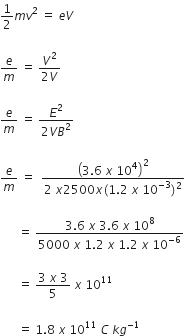 Short Answer Type
Short Answer TypeThe threshold wavelength of tungsten is 2400 Å.
When tungsten is illuminated with light of wavelength 1600 Å, find :
(i) Work function
(ii) Maximum kinetic energy of the emitted electron
(iii) Stopping potential.
Potential difference, V = 2500 V
Electric field, E = 3.6 x 104 V.m
Magnetic field, B = 1.2 x 10-3 T
Now, 
